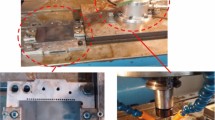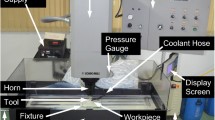Abstract
Engineering plastic components are generally drilled owing to the need for bolted, riveted or screwed structures, but formation of burr induces some difficulties in the assembly stage. The most practical method for deburring is to select proper cutting parameters and tool during drilling. This study investigates the formation of the exit burr height during drilling of ultra-high molecular weight polyethylene under three different cutting speeds (30, 40, 50 m/min) and feeds (0.006, 0.0125, 0.250 mm/rev). Also, three different types of HSS-based tools such as TiN-coated, TiCN-coated and uncoated HSS twist drill tools were used. The effects of cutting parameters and tools were the controllable factors in the experimental study. Experimental design and multiple regression analysis were utilized in determining the optimal parameters. The results showed that highest feed (0.025 mm/rev), lowest cutting speed (30 m/min) and uncoated HSS tool gave lower burr height due to the less deformation of the work material. Surface roughness of the drilled holes was also measured and almost similar effects of the controllable factors on surface roughness and burr height were observed. Finally, a relation between the burr height and type of chip was observed and it has been observed that the process variables increasing burr height gave irregular and highly deformed chips.



Similar content being viewed by others
References
Kurtz SM, Foulds JR, Jewett CW (1997) Validation of a small punch testing technique to characterize the mechanical behavior of ultra high molecular weight. Biomaterials 18:1659–1663
Barnetson A, Hornsby PR (1995) Observations on sintering of ultra high molecular weight polyethylene (UHMWPE) powder. J Mater Sci Lett 14:80–84
Chen KC, Ellis EJ, Crugnola A (1981) Effects of molding cycle on the molecular structure and abrasion resistance of ultra high molecular weight polyethylene. ANTEC 81(39):270–272
Salles JLC, Goncalves MTT (2003) Effects of machining parameters on surface quality of ultra high molecular weight polyethylene. Mater 8(1):1–10
Gaitonde VN, Karnik SR, Mata F, Davim JP (2008) Taguchi approach for achieving better machinability in unreinforced and reinforced polyamides. J Reinf Plast Comp 27(9):909–924
Palanikumar K (2011) Experimental investigation and optimisation in drilling of GFRP composites. Measurement 44(10):2138–2148
Palanikumar K, Latha B, Senthilkumar VS, Davim JP (2012) Analysis on drilling of glass fiber–reinforced polymer (GFRP) composites using grey relational analysis. Mater Manuf Process 27(3):297–305
Rubiol JC, Panzera TH, Abraol AM, Faria PE, Davim JP (2011) Effects of high speed in the drilling of glass whisker-reinforced polyamide composite: statistical analysis the roughness parameters. J Comp Mater 45(16):1395–1402
Davim JP, Reis P, Lapa V, Antonio CC (2003) Machinability study on polyetheretherketone (PEEK) unreinforced and reinforced (GF30) for application in structural components. Comp Struct 62:67–73
Gillespie LK, Blotter PK (1976) The formation and properties of machining burrs. Trans ASME J Eng Ind 98:64–74
Gaitonde VN, Karnik SR, Achhyutha BT, Siddeswarappa B (2008) Taguchi optimization in drilling of AISI 316L stainless steel to minimize burr size using multi-performance objective based on membership function. J Mater Process Tech 202(1–3):374–379
Nakayama K, Arai M (1987) Burr formation in metal cutting. CIRP Ann 36:33–36
Aurich JC, Dornfeld D, Arrazola PJ, Franke V, Leitz L, Min S (2009) Burrs-analysis, control and removal. CIRP Ann Manuf Techn 58:519–542
Lee K, Dornfeld DA (2005) Micro burr formation and minimization through process control. Prec Eng 29:246–252
Ko SL, Chang JE, Yang GE (2003) Burr minimizing scheme in drilling. J Mater Process Tech 140:237–242
Gaitonde VN, Karnik SR, Achhyutha BT, Siddeswarappa B (2008) Genetic algorithm-based burr size minimization in drilling of AISI316 stainless steel. J Mater Process Tech 197:225–236
Gaitonde VN, Karnik SR (2012) Selection of optimal process parameters for minimizing burr size in drilling using Taguchi’s quality loss function approach. J Braz Soc Mech Sci 34(3):238–245
Silva JD, Saramoga SDP, Machado AR (2009) Optimization of the cutting conditions for burr minimization in face milling of mould steel. J Braz Soc Mech Sci 31(2):151–160
Xiao KQ, Zhang LC (2002) The role of viscous deformation in the machining of polymers. Int J Mech Sci 44:2317–2336
Kobayashi AK, Saito K (1962) On the cutting mechanism of high polymers. J Polym Sci 58:1377–1395
Ferecau C, Stan F, Popa V (2008) Machining and surface integrity of polymeric materials. Int J Mater 1(1):515–518
Carr JW, Feger C (1993) Ultraprecision machining of polymers. Prec Eng 15:221–237
Ross PJ (1996) Taguchi techniques for quality engineering, 2nd. McGraw Hill, Singapore, pp 208–212
Endo H, Mairu E (2006) Small hole drilling in engineering plastics sheet and its accuracy estimation. Int J Mach Tools Man 46:575–579
Ahmad Sheikh JY (2009) Machining of polymer composites, 1st edn. Springer, New York, pp 196–197
Altan M (2012) Investigation of burr formation in drilling of ultra high molecular weight polyethylene by Taguchi Method, 3rd National Machining Congress, pp 474–479
Brito RF, Carvalho SR, Silva LMMS, Ferreira JR (2009) Thermal analysis in coated cutting tools. Int Commun Heat 36:314–321
Kusiak A, Battaglia JL, Rech J (2005) Tool coatings influence on the heat transfer in tool during machining. Surf Coat Tech 195:29–45
Author information
Authors and Affiliations
Corresponding author
Additional information
Technical Editor: Alexandre Mendes Abrao.
Rights and permissions
About this article
Cite this article
Altan, M., Altan, E. Investigation of burr formation and surface roughness in drilling engineering plastics. J Braz. Soc. Mech. Sci. Eng. 36, 347–354 (2014). https://doi.org/10.1007/s40430-013-0089-8
Received:
Accepted:
Published:
Issue Date:
DOI: https://doi.org/10.1007/s40430-013-0089-8




